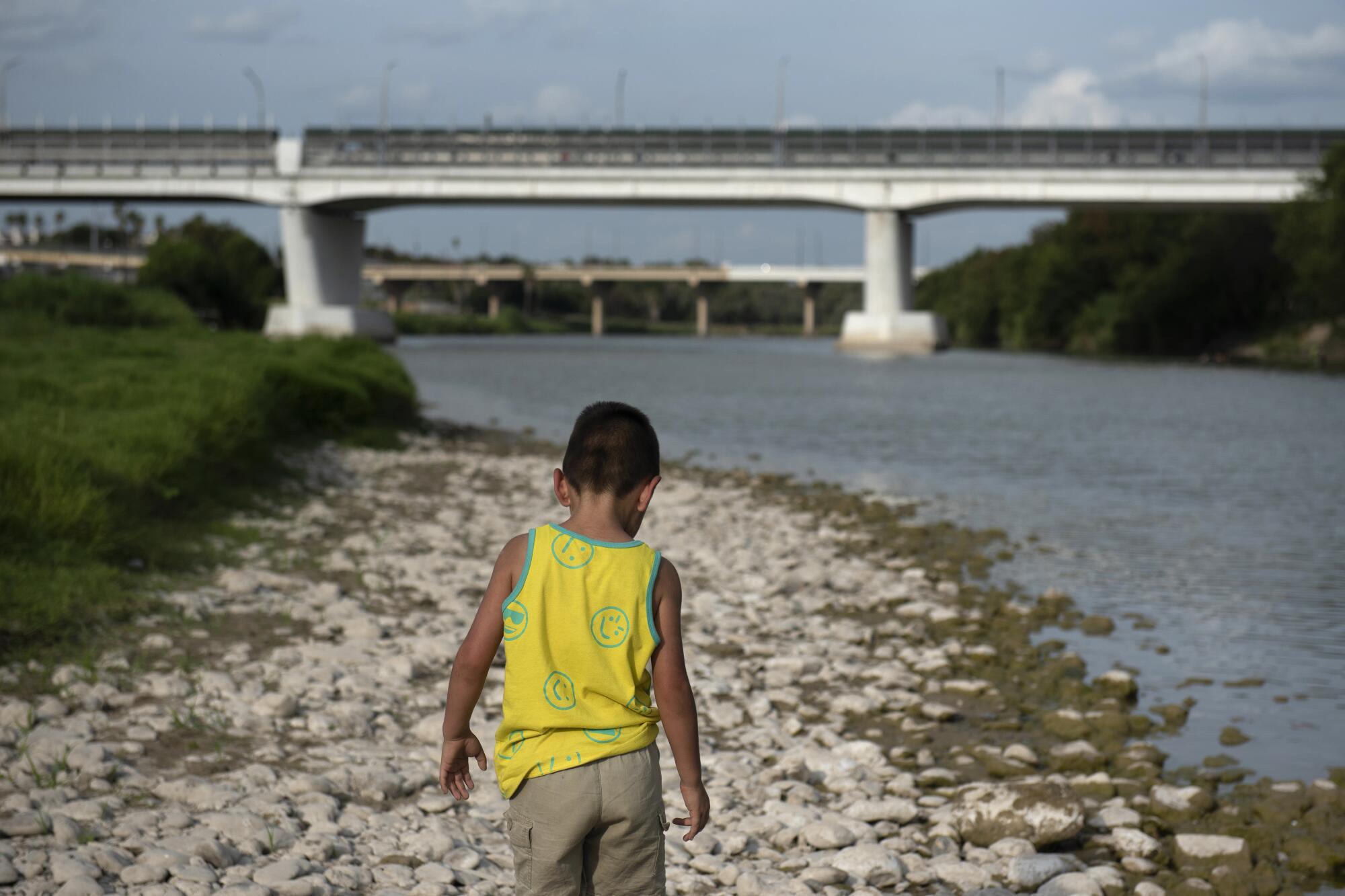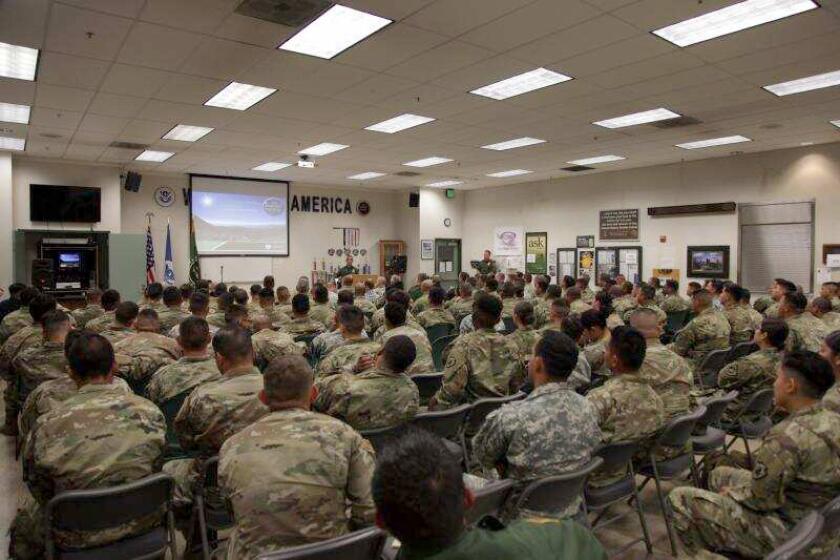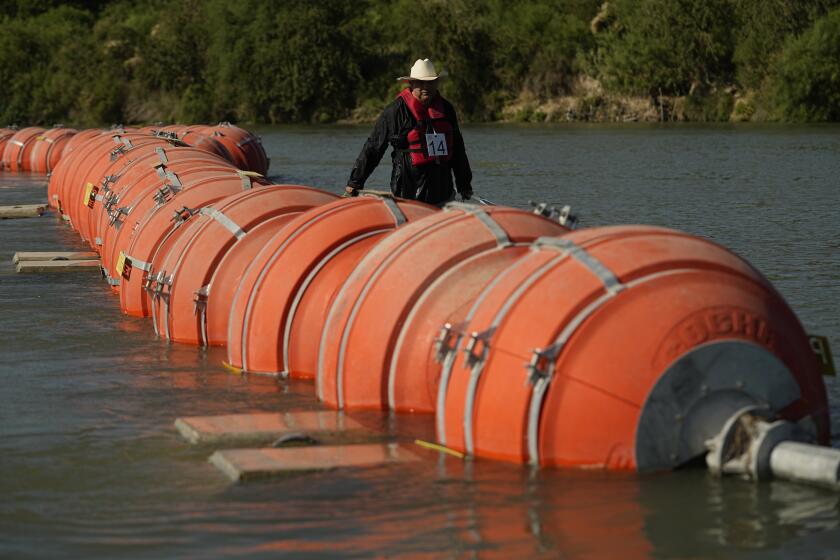
- Share via
“Laredo is like the goose that lays the golden eggs,” says Alec Martinez, a local resident who has worked in city government. “Everyone is interested in the eggs, but no one cares about the goose.”
This border city has become the largest inland port in the nation. At the same time, much of Laredo’s historic downtown with its eclectic architecture, once a bustling business center, stands forlorn with inadequate residential housing and scattered shops. The flow of money has shifted from the city itself to the four international bridges tying the local economy to the crumbs of international trade. Homegrown economic growth helped bring prosperity to the city in the 1960s and ’70s. The 1994 North American Free Trade Agreement, however, transformed the beautiful downtown and the mighty Rio Grande into a mere passage for money, merchandise and narcotics.
The proposal, which recalls President Reagan’s efforts to limit asylum seekers’ movements in the late 1980s, is likely to draw fierce opposition from immigrant rights groups and border-state officials.
As media coverage of the southern border focuses on the growing number of asylum seekers, the associated humanitarian debacle and the partisan politics surrounding migration policy, longtime border residents get left out of the narrative. “Decisions made in Washington, D.C., dictate our lives,” says Sandra Taylor, a local pub owner. “They don’t understand the border; they don’t talk to us.”
Vicky Garcia moved to Laredo from Chicago and chose to buy a house built in 1890 in the historic downtown. “The architecture here — the French style, the little white homes, the ornate ones — tells the history of colonial days, the Civil War, buffalo soldiers,” she tells me. Now she regularly wakes up to gunshots heard across the river, the sound of buzzing helicopters and her view of the riverbank obstructed by the migrant processing center that was built in 2019. The city’s customary activities of fishing, boating and birding have largely evaporated as dust from Border Patrol cars clouds the air and surveillance boats produce mechanical noise.
Moreover, people are concerned about the safety of their drinking water as the Border Patrol implements new security projects that pollute the river. The Rio Grande International Study Center, an environmental nonprofit in Laredo, regularly monitors the water. Tricia Cortez, the organization’s executive director, laments: “Unless and until the slow contamination of the river reaches Flint crisis levels, no media coverage of the border will include the hazards to safe water as a byproduct of border security.”
Instead of busing migrants and doing other stunts, why don’t politicians look to the past for policy ideas that could improve our asylum and work permit systems?
But in recent years, on top of seeing some redevelopment, Laredo has been at the forefront of a trend in the region: locals pushing back against authorities to retake control of land and resources.
In 2020, residents of Webb County (which contains Laredo) and Zapata County filed lawsuits against the Trump administration to protect land from being confiscated by the federal government for border wall construction. Had the wall been built as planned, Elsa Hull’s three-acre homestead in San Ygnacio, just south of Laredo, would have been sandwiched between the wall and the Rio Grande. Hull joined as a plaintiff onto another lawsuit, brought by Earthjustice in 2019, to oppose the wall. “I had no other choice,” she tells me. “I was going to lose my house, my livelihood as a rancher, my whole life. I was going to be trapped in no-man’s land with my daughters and animals.”
And this August, the Eagle Pass City Council voted unanimously to rescind permission for the Texas Department of Public Safety to use Shelby Park to arrest migrants on criminal trespassing charges.
Gov. Newsom will increase the California National Guard presence at the southern border. Fentanyl is “ripping families and communities apart,” he says.
Militarized border policies face other setbacks: The Biden administration canceled the border wall contracts in 2021, and last week a judge ordered Texas Gov. Greg Abbott to remove the buoy wall he constructed on the Rio Grande to block migrants. But the militarization has already wreaked havoc: In Eagle Pass, government-installed razor wire has injured migrants while tearing up a family’s pecan farm, and residents say buoy construction has unsettled pollination cycles.
These clashes reveal a gaping distance between official and local narratives of the border’s fundamental meaning. How can sustainable policy be implemented under these conditions?
While state and national policies aim to keep Texas and Mexico separate, local initiatives are trying to unite the two sides of the river. Even as the governor pursues a physical barrier — Abbott almost immediately appealed the buoy order, prompting a stay — Laredoans are excitedly awaiting the construction of the River Vega project, a binational park planned to run along the much-maligned Rio Grande for residents of Laredo as well as Nuevo Laredo across the border. This project has grown out of a community-driven master plan, Viva Laredo, focused on reanimating the historic downtown and enhancing quality-of-life features for residents.
A federal judge has ordered Texas to move a large floating barrier to the bank of the Rio Grande by Sept. 15.
Frank Rotnofsky, one of the architects involved with the project, envisions this park as being akin to San Antonio’s popular River Walk, with the broader goal of regenerating the Rio Grande and creating more recreation spaces in the downtown area. As Rotnofsky says: “River Vega is going to connect the edges of two countries, the two riverbanks, in the most sustainable way, both with regard to the environment and human relations.”
Border people remain the missing element in so much state and national policy. “Border cities are being treated like empty spaces where anything can be constructed anywhere. We are a living community. This is the land of our ancestors. Why are we not part of these life-altering decisions?” asks Ricardo de Anda, a lawyer who fears the construction of a border wall that would diminish his access to land that has belonged to his family since Laredo was part of Mexico.
From a democratic and pragmatic standpoint, no border policy can work unless it incorporates local interests and allegiances. Disagreement over particular strategies will arise, but without dialogue and local participation, the border will continue to be mistreated as an abstraction — a wedge issue between political foes — instead of the hub of communities it really is.
Mehnaaz Momen is the author of the forthcoming book “Listening to Laredo: A Border City in a Globalized Age.”
More to Read
A cure for the common opinion
Get thought-provoking perspectives with our weekly newsletter.
You may occasionally receive promotional content from the Los Angeles Times.













